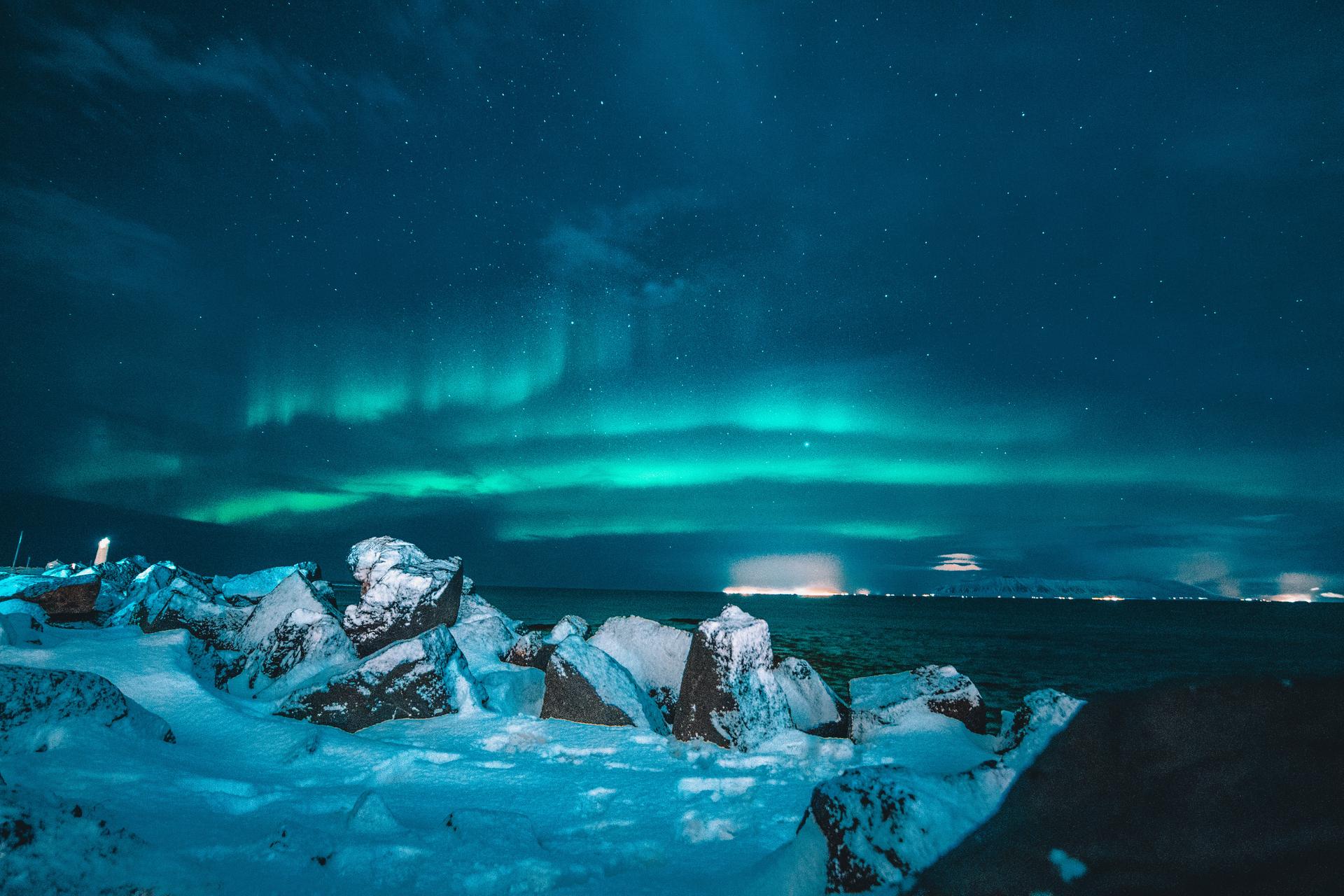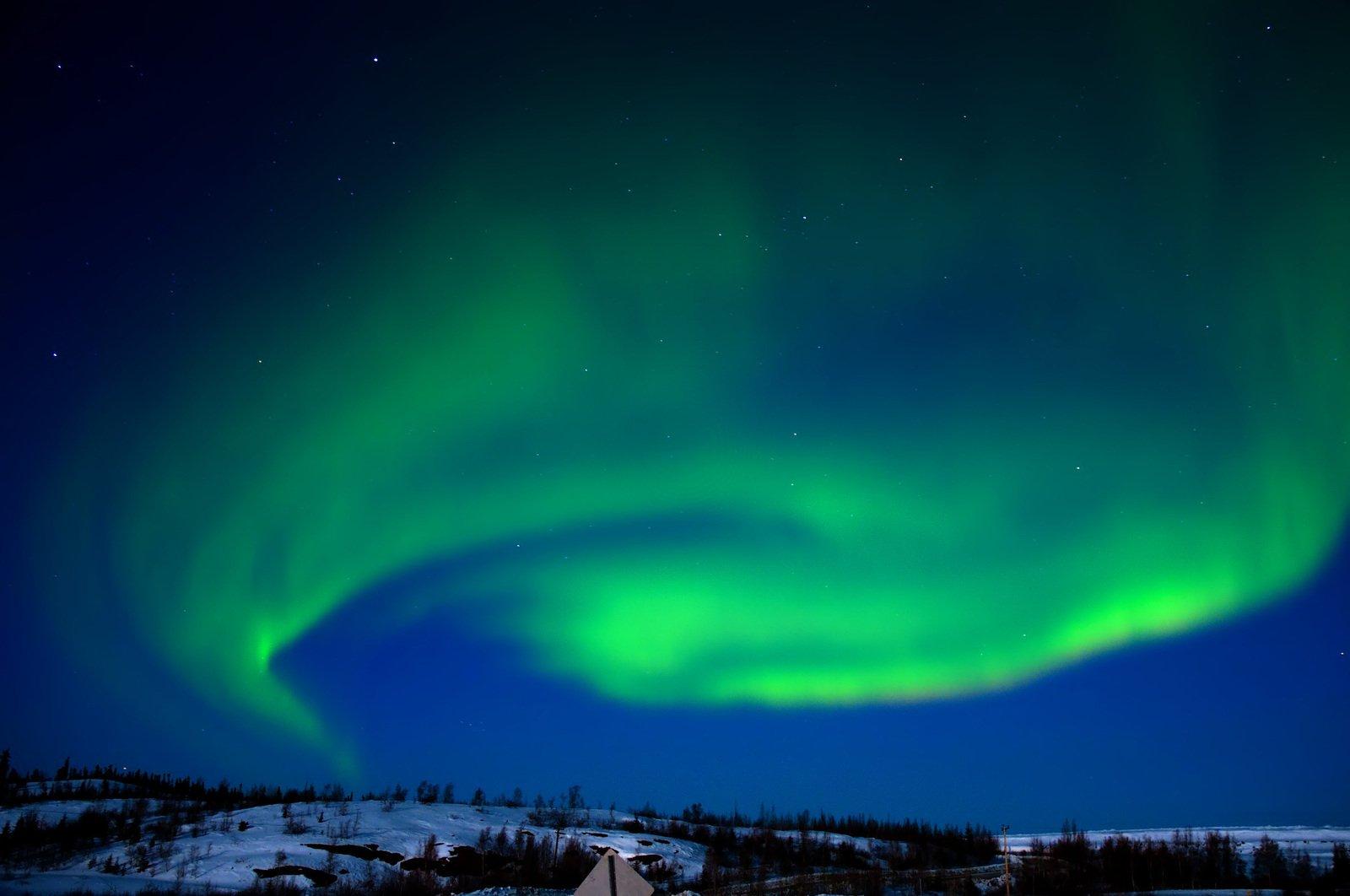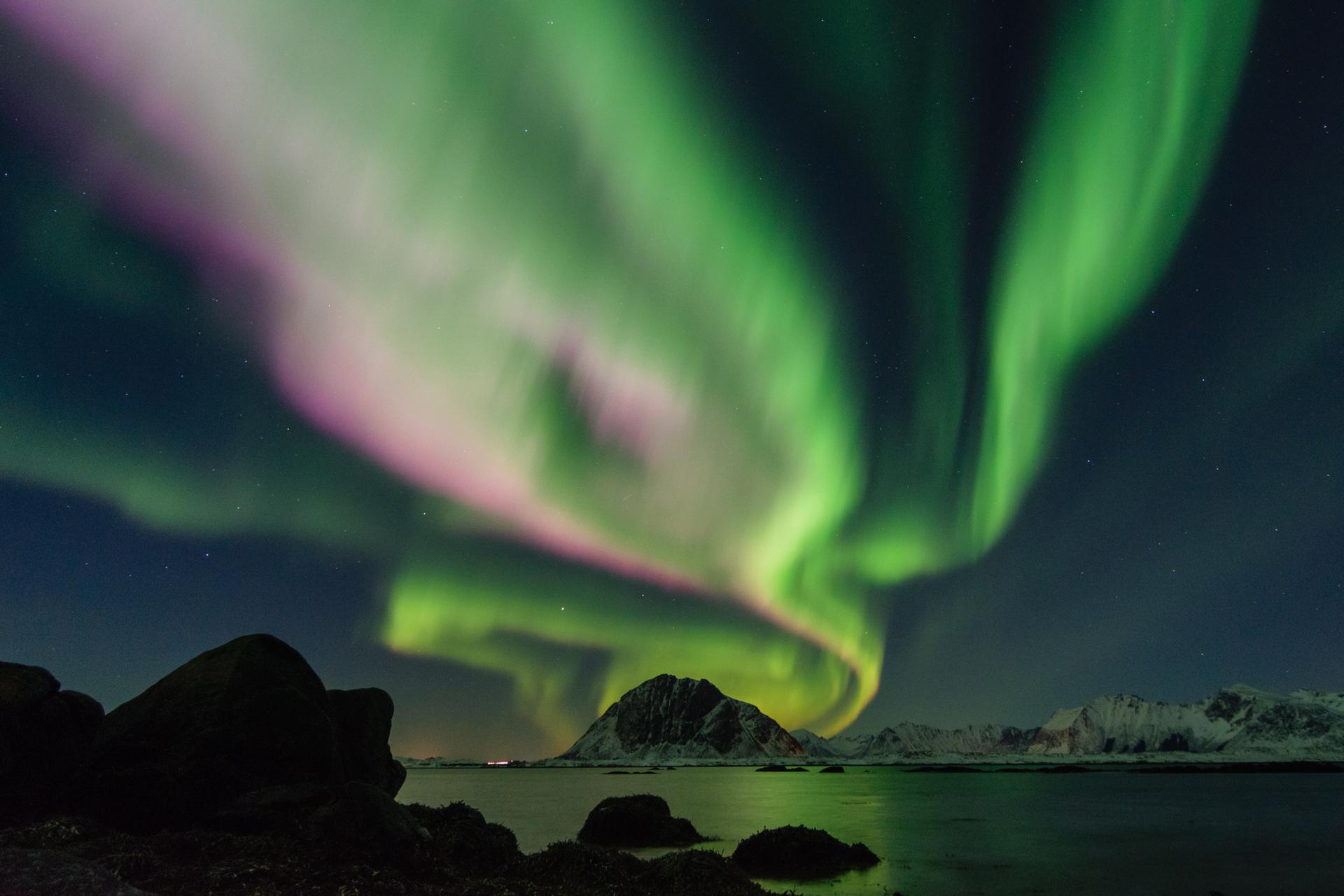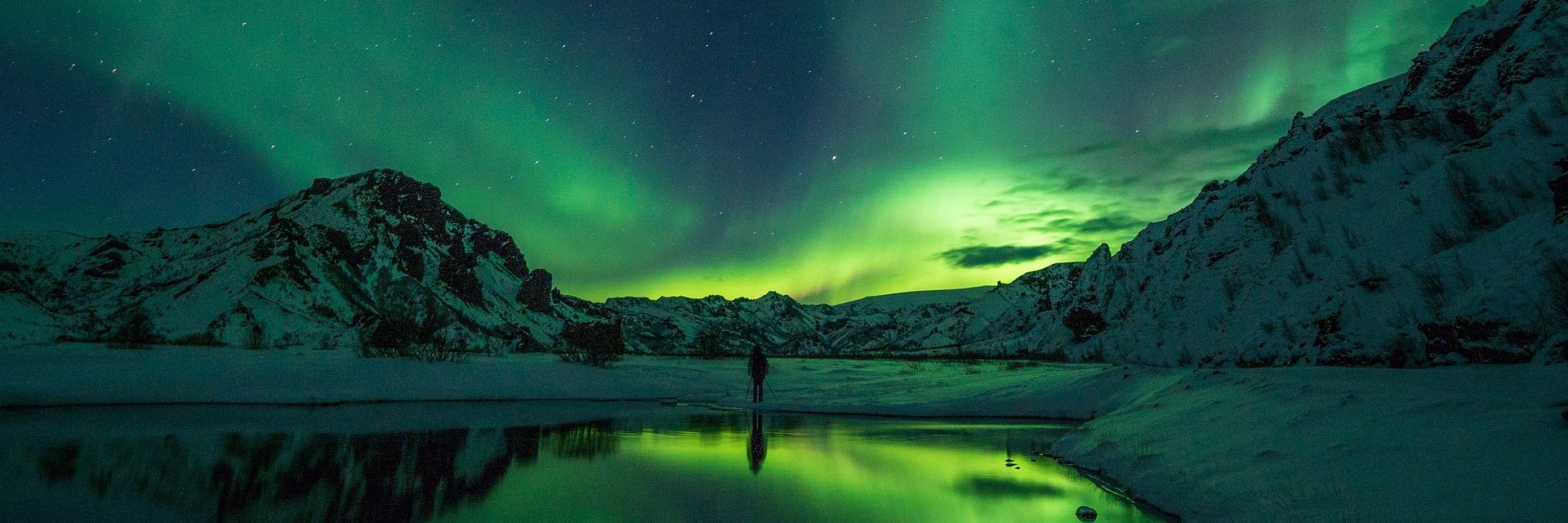The auroras are elusive phenomena that light up the far northern and southern skies during the colder months of each hemisphere’s year. They can be seen in both Earth’s Northern and Southern Hemispheres, and they are among the most intriguing astronomical sights of all, inspiring humans for thousands of years. Let’s explore the science behind how these magnificent light shows are made, as well as some of the folklore that ancient civilizations created to explain their mysterious existence.
◊
In the climax of The Golden Compass by Phillip Pullman, a character named Lord Asriel creates a window to a mysterious parallel universe called Cittàgazze, or “city in the sky.” The book goes on to explain that the city is visible in the northern lights, and the lights themselves thin the barrier between our world and that one, making it easier to cross over.
Perhaps that book, which I read as a young child, was the root of my fascination with the aurora borealis. I’ve searched for it on trips to Iceland, Alaska, and Denmark over the years, but I have never been able to spot it. I’m not alone. Millions of tourists travel around each year hoping to catch a glimpse of that entrancing, iridescent glow. And countless people across time have shared my fascination with the lights, which seem surreal and magical, one of nature’s many magnificent displays of improbable beauty. The northern lights have spawned myriad myths and legends that speak as much to cultures’ values as they do to the auroras’ enduring hold on the collective imagination.
While scientists only recently pinpointed the actual cause of the lights – which has to do with the Sun’s rays coming in contact with the Earth’s magnetic field – looking at them (or looking at photos of them, as I do frequently), it’s easy to wonder if they’re flickers of parallel universes or indications of some cosmic presence watching over us.
Explore the beauty of the aurora in the MagellanTV series Morning Glory episode Norway: A Long Morning after the Polar Night, which delves into the harsh beauty of Norwegian winters.
A Violent Dance With the Sun: How the Auroras Form
The current scientific consensus holds that auroras are created when solar disturbances, such as solar flares, pull on Earth’s magnetic field, creating a tension much like a slingshot. When the tension is released, a stream of charged electrons shoot at high velocity along Alfvén waves and bang into atoms and molecules such as oxygen and nitrogen.
The collision creates a burst of electricity, which either causes nitrogen atoms to regain an electron (a process which is called ionization) or causes electrons in oxygen and nitrogen to move from a ground state to an excited state and then back to a ground state. Both of these processes result in the release of infinitely numerous tiny bursts of light called photons. These photons knit together to form the luminous phenomenon we call an aurora.
An electron’s ground state is an electron at its lowest possible energy level, and an electron in an excited state is an electron that occupies any higher energy state than its ground state. An electron can become excited when it absorbs a photon, or collides with a nearby atom or particle.
Typically, photons resulting from collisions with oxygen display a green or brownish red color. Photons resulting from from interactions with nitrogen tend to appear blue if the atom regains an electron after it’s been ionized, or red if the atom returns to a ground state from an excited state.
Once the photons flicker into being, Earth’s magnetic field then shifts the photons toward the magnetic poles, which is why most of the auroras we can see emanate from the North or South Pole.
 The aurora as seen from Iceland. (Credit: Nicolas J. Leclercq via Unsplash)
The aurora as seen from Iceland. (Credit: Nicolas J. Leclercq via Unsplash)
For a long time, however, scientists were unable to prove their theories about how the auroras formed, as until recently it was too difficult to simulate space’s immense size in a lab. But a June 2021 study from the University of Iowa finally proved that the prevailing theory about electromagnetic waves is indeed correct, finding a “clear causal relationship between Alfvén waves and accelerated electrons that directly cause auroras,” as reported by NPR.
Using an instrument called a Large Plasma Device at the Basic Plasma Science Facility at the University of California, Los Angeles, scientists were able to re-create the interaction between Alfvén waves and electrons. The University of Iowa study found that Alfvén waves do push articles toward the Earth, energizing the electrons that form the auroras.
“It was sort of theorized that that’s where the energy exchange is occurring," said Gregory Howes, associate professor of physics and astronomy at the University of Iowa. “But no one had ever come up with a definitive demonstration that the Alfvén waves actually accelerate these electrons under the appropriate conditions that you have in space above the aurora.”
Auroras in History, Legend, and Poetry
Long, long before we understood exactly how auroras formed, people have admired and questioned the auroras’ glittering presence in the night skies – and naturally, this led to a great number of theories and even superstitions about their significance.
Records of the aurora borealis’s colorful presence date at least all the way back to the reign of King Nebuchadnezzar II in ancient Babylon. On a clay tablet from around 567 BC, the king describes a mysterious “red glow” in the sky at night, which most likely is a reference to the aurora borealis. Several other cuneiform tablets from the Assyrian Empire dating from 680 to 655 BCE also make reference to strange red glows in the sky.
The ancient Greeks believed that the northern lights were caused by the goddess Aurora as she raced across the sky in her multicolored chariot. According to Greek poet Hesiod’s Theogony, Aurora was the daughter of the Titan Hyperion and the Titaness Theia, and the sister of Selene, goddess of the Moon, and Helios, god of the Sun. In some works of art, Aurora is depicted as a young woman, sometimes with wings and other times pouring out the dews of the morning from jars she carries in her hands.
In Finnish lore, the aurora is created by a firefox as it runs across the sky, leaving sparks flying behind it. Ancient Chinese folklore describes the aurora as the byproduct of a cosmic fight between good and evil dragons. Nordic mythology sees the lights as gifts from benevolent gods and signs of bountiful harvests.

Canadian northern lights. (Credit: Dave Dyet via freeimages.com)
North American Indigenous peoples have a variety of legends surrounding the lights. The Cree believed the lights were spirits of the dead, sending flares and signals back to their loved ones on Earth. Inuit tribes also believed that the lights were the spirits of the dead.
Naturally, the auroras have provided fodder for many artists and poets. Alfred Lord Tennyson describes the aurora borealis in his poem “Tithonus,” writing of a “mysterious glimmer” that can “shake the darkness from [the stars’] loosened manes / And beat the twilight into flakes of a fire.”
In 1619, Galileo Galilei coined the term “aurora borealis” for the northern lights in reference to Aurora, the aforementioned Greek goddess of the morning, and Boreas, the god of the north wind. Soon after, the scientist Henry Cavendish used a technique called triangulation to make the first quantifiable observations of the aurora, and the rest, as they say, was history.
How and Where You Can See the Auroras
If you want to see an aurora, you’ll need a combination of advance planning and luck. The lights are notoriously difficult to predict and track, and it’s nearly impossible to guarantee that they will appear at any given time or location.
The best time to see the aurora borealis in the Northern Hemisphere is when the skies are darkest, meaning December through March. The best places to see them are usually near the Arctic Circle, making Alaska, Canada, Sweden, Greenland, and Norway all good options.
 Northern lights over Lofoten, Norway. (Credit: Johannes Groll via Unsplash)
Northern lights over Lofoten, Norway. (Credit: Johannes Groll via Unsplash)
Also, Fairbanks, Alaska, is known as one of the best places in the world to see the northern lights, as it’s located right underneath the Auroral Oval, a huge ring above the Earth’s geomagnetic North Pole where the aurora borealis typically appears. The city of Tromso, Norway, is regarded by some as a prime location to see the northern lights, offering views all the way from September through April.
The National Oceanic and Atmospheric Administration (NOAA) website has plenty of information on how to view the lights in the upcoming months, but NOAA employee Rodney Vierek has some simple advice for those seeking the lights: “Be patient and go north.”
If you’re looking for an even more elusive experience, you can also see the aurora australis from parts of the Southern Hemisphere. These auroras can be spotted from locations in far southern regions of Australia, including Tasmania, and New Zealand. In New Zealand, the small village of Queenstown has provided residents and visitors with stunning views of red and green lights.
In Tasmania, a climb up 1,400-foot Mount Wellington is likely to provide you with the best views of the aurora in the southern hemisphere, if you’re lucky enough to see it. And in Australia, the Victoria coastline has provided lucky visitors with extraordinary views of the luminous dancing light show the skies sometimes put on.
But really, the best place in the southern hemisphere to see the lights is Antarctica and surrounding territories like the remote South Georgia Island – if you’re brave and hardy enough to make it out there, that is. If you manage to brave the sub-zero temperatures and the howling, icy winds, you might be lucky enough to catch a glimpse of the southern lights from one of the southernmost inhabited parts of the planet.
Searching for the Lights
No matter how carefully you plan your trip or how far into the wilderness you trek, seeing an aurora is always going to require a little bit of plain old good fortune. But according to what I’ve read, the sight is pretty awe-inspiring and worth seeking out time and time again.
Here’s how Phillip Pullman describes the northern lights in The Golden Compass:
The sight filled the northern sky; the immensity of it was scarcely conceivable. As if from Heaven itself, great curtains of delicate light hung and trembled. Pale green and rose-pink, and as transparent as the most fragile fabric, and at the bottom edge a profound and fiery crimson like the fires of Hell, they swung and shimmered loosely with more grace than the most skillful dancer… She was moved by it; it was so beautiful it was almost holy; she felt tears prick her eyes and the tears splintered the light even further into prismatic rainbows.
Whether or not the lights contain a parallel universe within them, they definitely speak to a lot of majesty and beauty in our own universe. For scientist Jim Schroeder, lead author of the University of Iowa article that proved how the auroras form, they certainly do just that.
The lights “[appeal] to our sense of awe and wonder,” he told NPR. “We’ve been captivated by auroras for thousands of years and looking at the night sky and appreciating their beauty. And I've always found that understanding more about how something is created enhances my appreciation of that beauty.”
While I still haven’t managed to see the lights, just knowing about them inspires awe and wonder. They continue to evade me. Once, they apparently were visible as I slept on a flight from Anchorage, Alaska to New York, but no one thought to wake me up. And as I write this article from California, the Northern Lights are reportedly visible in parts of the northeast U.S., where I lived until about a year ago. But perhaps their elusiveness makes them more enchanting to me, their mystery part of their grand allure. One day I’ll catch up to them.
Ω
Eden Arielle Gordon is a writer, editor, and musician based in San Francisco, California. She graduated from Barnard College with a BA in English, and her work has been published on Popdust.com, Lilith Magazine, and Untapped Cities, among others.
Title Image credit: Jonathan Pie, via Unsplash

